Chinese Traditional Color Harmony Inheritance Method for High-speed Railway
- DOI
- 10.2991/jrnal.k.211108.015How to use a DOI?
- Keywords
- Chinese traditional color scheme; color harmonies; high-speed railway interior color scheme design; interactive design tool
- Abstract
The construction and development of China’s High-Speed Rail (HSR) in recent years have attracted the attention of the world, but the localization and humanistic design of China’s HSR are lacking. To cater to the development of the times and the needs of society, the color scheme concept of China’s HSR needs to have national and contemporary cultural connotations. In the research, we based on the core concept of Chinese traditional color culture, this research proposes a website interaction color scheme tool for HSR which is oriented Chinese traditional color harmonious. The evaluation of experimental results and user experiments show that the interactive system can effectively generate, optimizing and obtain the harmonious and reasonable relationship of Chinese Traditional Color Schemes (CTCS) and visual effect inside HSR. This research explores the localized design concept of HSR, and expands the application scope of CTCS, reduces the dependence of color scheme design on professional knowledge, and provides an effective method for inheriting Chinese traditional color culture.
- Copyright
- © 2021 The Authors. Published by Atlantis Press International B.V.
- Open Access
- This is an open access article distributed under the CC BY-NC 4.0 license (http://creativecommons.org/licenses/by-nc/4.0/).
1. INTRODUCTION
In 2018, the total operating mileage of China’s High-Speed Rail (HSR) went beyond 29,000 km, and the history of HSR operation exceeded two-thirds of the history of HSR trains in the world, making it the country with the longest operating mileage and the highest HSR network density in the world. The train is a mobile living space. While bringing convenience to people, it also provides a unique experience process. The internal space design of the HSR is not only a design for physical space, but also a process of creating an emotional experience. The comfort of passengers during travel does not only come from totally physical satisfaction, but also includes the experience of comfort, happiness, efficiency, and convenience during the ride. Appropriate color scheme of interior environment will improve the experience of people’s activities in the surrounding conditions. Maslow believes that the process of human needs is a process of continuous development from low to high, from material to related religion or the spiritual. When people are in a space with a good surrounding condition, their feeling of happiness, joviality, satisfaction etc., physical strength, intelligence and even spirit can reach a certain level, so that they can have a good feeling in their consciousness and feel comfortable [1]. As a means of transportation, the design focus of the train is consistent on the research fields of ergonomics such as improving efficiency, increasing safety, and improving ride comfort, although the environment inside the HSR exists in a material form and affects the psychology, emotion, and aesthetics of the passengers. But the aesthetic design of human emotions, such as environmental beauty, has always been placed in a secondary position. With the improvement of living standards, consumers’ demand for HSR has changed from simply carrying the needs of transportation to more complex emotional needs. Therefore, it is necessary to gradually improve the HSR surrounding condition that meets the physical and mental comfort of the people.
High-speed rail as an important carrier for carrying and disseminating culture. The perceptual factors of color play a vital role in creating an overall environmental impression and shaping a special brand image, which is related to atmosphere or style. Related research has elaborated on the interior color design of HSR. Lei and Xiao [2] conducted a related study on HSR seats and colors through the gray correlation analysis method. Shen and Hou [3] proposed a HSR interior color design method with a natural color system. Liang-kui et al. [4] put forward a new aesthetic design concept for HSR interior matching based on the analysis of regional cultural characteristic elements. Jiang et al. [5] conducted experimental research on the color and pattern of the train seat mask and put forward design suggestions. However, there are still many imperfections in the relevant design of China’s HSR. For this research, we think how to use and recreate traditional and national color scheme is the one of most important aspect for it.
To the summary, the problem of traditional and national color scheme in the interior environment of HSR is mainly due to three factors: (1) Compared with the single-color element, the visual perception and cognition formed by multi-color superposition are more complicated; (2) The color combination is too complicated. It is difficult to study; (3) The user’s color preferences are very different, and it is impossible to accurately capture and cater to [6]. For these reasons, this research aims to explore the harmonic and reasonable relationship of Chinese Traditional Color Culture (CTCC) in the HSR’s environment. Based on the system architecture proposed in the previous work [7], this research proposes a HSR interior environment interaction system based on Chinese traditional color aesthetic principles and design principles. The purpose is to obtain the color-matching data on the Chinese Traditional Color Schemes (CTCS) characteristics suitable for humans. Then, as an application expansion, this research built a virtual reality, interactive system which is based on the Unreal Engine and preliminary research data. This system can generate the Chinese traditional color scheme based on the perceptual images of the experimenters’ data.
2. RESEARCH METHOD
2.1. Aesthetic Principle
The principle of Five-Color combination. In traditional Chinese philosophical values, the philosophical concept of Yin and Yang and the five elements is the foundation of all things in the world [8]. It has lasted for more than 2500 years in China. The five-form, color combination is the most harmonious Chinese traditional color. Commonly used expressions, in the traditional five element colors, five colors refer to the five color categories that are usually expressed as the blue, the red, the yellow, the white, and the black [9]. The black and the white symbolize Yin–Yang in the theory, and it means two-side of world which are construct by five elements. The surface meaning of Yin and Yang are opposites. As the black and the white have no hue, in the traditional Chinese color harmony method, the black and the white are combination with other colors to achieve color brightness and purity. The change of saturation produces different ways of color matching. Traditional Chinese color harmony is based on the observation of nature and the accumulation of experience.
The principle of common elements, it as one of the important theories of modern chromatology, originates from the principle of color harmony in human observation of nature, the sense of unity produced by basic toning. If it is a certain hue, the base color is called the dominant tone, and if it can perceive the commonality or dominance of the color, it is called the dominant tone. The main base color and the auxiliary base color play a major role in human perception and emotion. The image formed by color or color collocation is derived from the enlargement of common elements. Although the image and emotion of color vary greatly from person to person, there is a common phenomenon in it. even though the person which come from different cultural background, the cognitive of some colors will not be very large, such as red. Express the symbol of warmth, while blue symbolizes coldness. However, as the number of color elements increases, the complexity of perception will also change. The visual proportions of the dominant tone and minor tone of the spatial color scheme are the main factors that form the image of color scheme, and the visual focus point will also have a secondary impact [10].
2.2. Design Principle
For the modern design industry, the relevant design process through digital methods can save development costs, speed up work efficiency, and obtain better visual effects, thereby obtaining accurate positioning of the content of the design [11]. At the same time, it also needs attention from the past. The function and performance of the product to the current product experience and feelings of consumers [12]. According to the ergonomics point of view, human experience and feeling belong to the cognitive layer and perceptual layer, which mainly refers to the feeling and perception form that people produce on objects. Environmental context will affect people’s perception of surrounding things, and feelings and emotions will affect users’ perception and judgment [13]. For color design, from idea to finished product or environment is a complete chain connected. This chain connects the color itself (that is, human feeling) and production, including (A) Creative feeling and concept; (B) Visual analysis of the environment and material reality; (C) Planning and selection, and establishing the final color concept; (D) Explain the selected color; (E) Carry out production and control the selected color [14].
Essentially, human perception or perceptual cognition is controlled by the visual quality and determines the evaluation of perception. Physical conditions such as the light source and color tone are just the way to achieve visual quality. Visual comfort is the aesthetic experience of the environment, a continuous spatial experience that includes time and action, and includes space and linear continuity. The characteristics of visual content are shape, color, line, texture, proportion, and continuity. The evaluation and quality assurance of visual quality includes vividness, completeness, unity, sense of place, sense of belonging, etc. On the other hand, under the condition of the same lighting, the color harmony of the color scheme method is the main reason for the visual comfort [15]. The environmental color configuration mainly includes color harmony, color preference, and the perceptual characteristics of color space. Color harmony relates to people’s satisfaction with the quantity or two or more colors in parallel, which is one of the main contents in color comfort research.
For this study, we think that the single-color element could not express cultural attributes and satisfy perceptual needs. Only through the sorting and recombination of color groups can the expression meaning with national characteristics be formed, and then people can get a sense of comfort. But this perceptual approach requires a process of digital quantification and analysis. The system of this study follows the above principles and realizes the extraction, generation, and optimization of traditional Chinese color matching cases of five-color combinations through the operation logic set by this research. In addition, the system uses built-in data and logic settings to assist users in creating a space color scheme for the train environment that they believe is beautiful and comfortable with Chinese traditional styles in a short period of time.
3. SYSTEM OVERVIEW
3.1. Operation Logic
The operation logic is mainly divided into four steps: (1) The color scheme and extraction of traditional Chinese artworks, and the system generates corresponding color scheme according to the color tends of the user’s preference. (2) The system will record the color matching information and provide the generalized aesthetic score of the color palette. (3) If the user is not satisfied with the extracted color palette, the system will optimize and regenerate the color matching image characteristics uploaded by the user. (4) Collection of interactive coloring results. The system records each parameter in the user’s operation process, such as user operation time, color matching optimization times, etc., as evaluation data.
3.2. Model Architecture
The model architecture is based on our previous research work [7]. The overall model architecture is shown in Figure 1A. Three research models were used to construct the model architecture, which are the lasso regression model, the Neural Image Assessment (NIMA) model, and the Wasserstein Generative Adversarial Net-Gradient Penalty (WGAN-GP) model [16–20]. The Lasso regression model trained by the data which is obtain from the experiment can effectively extract traditional Chinese colors, such as Equation (1). The NIMA model gives a universal aesthetic score for judging color scheme is shown in Equation (2), in Figure 1B. The WGAN-GP model evaluates and optimizes the input graphics to generate color-matching with universal aesthetic characteristics, such as Equation (3), in Figure 1C.
p is one of the topics selected from the candidate colors; dist(p, h) represents the distance between p and h; max Dist is the maximum possible distance between the two topics.
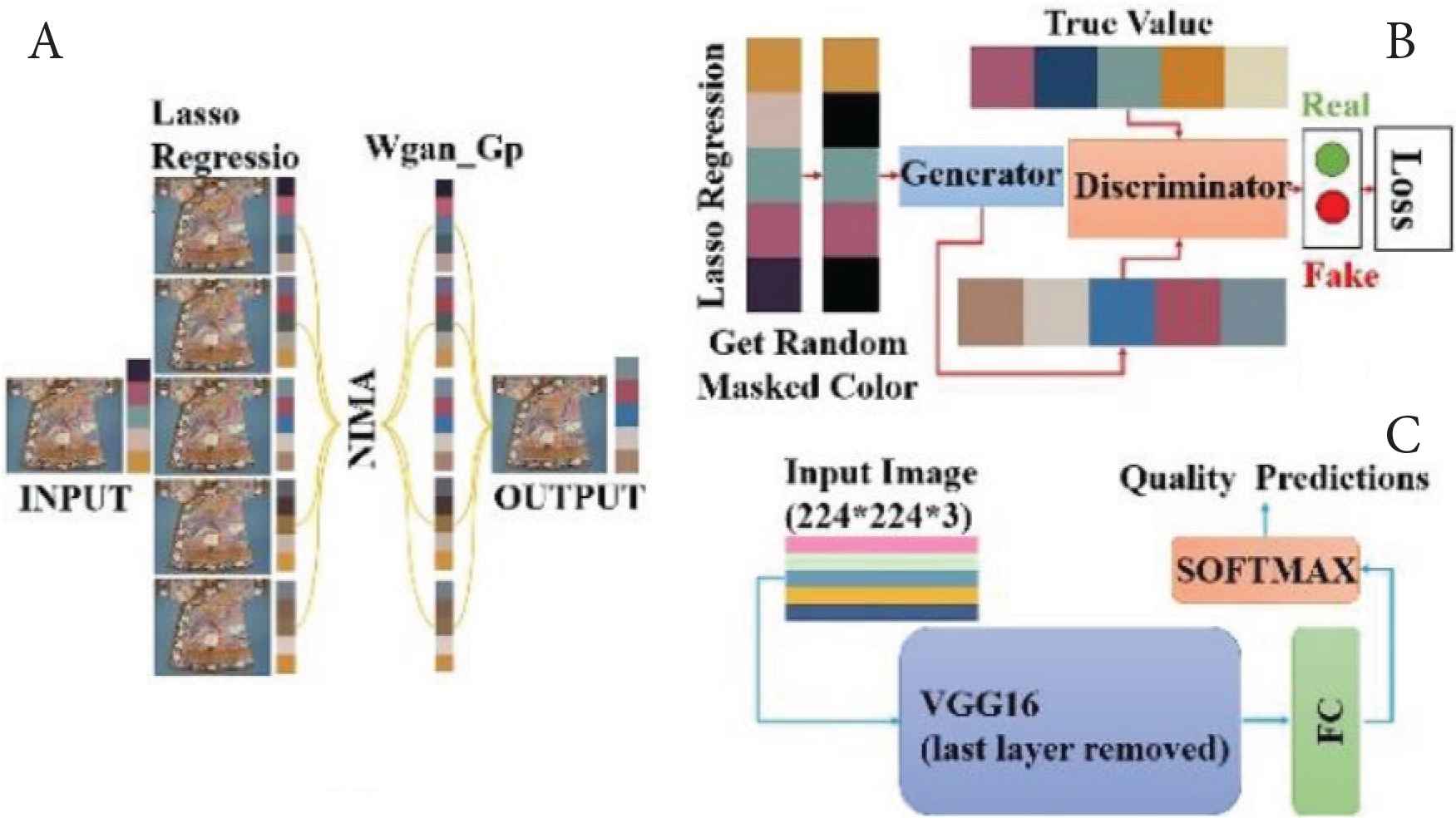
Model architecture.
After training research data, the NIMA model can score images with a reliable score close to the level of human perception. The loss function used in this model is EMD, as shown in Equation (2).
p is the user’s rating distribution of the picture;
4. EXPERIMENT
4.1. Participants
We conducted a user study and we distributed our web and operating instructions to the public by WeChat Platform. During the experiment, the interactive program database collected a total of 95 valid user information, including 62 males and 33 females. There are 26 people with design or aesthetics majors and 69 people with non-design majors. Before the experiment, each participant was tested for color-blindness using the Ishihara Color Vision Test. Participants were confirmed to have no mental illnesses and psychological problems. The Web link: (http://114.55.166.12:23225/autocolor/index.html).
4.2. Interactive System Overview
The website system of this study is built by Three.JS. The HSR model is based on the China railways high-speed, second-class seat model, base upon that the work model is built as shown in Figure 2. The train model is established in 3Dmax version 2020 based on the real train data. The details and structures of the model are shown in Figure 3. The system provides customizable train internal components. Users can adjust the main components of the three-dimensional space according to their preferences for color matching operations and customize spatial setting with environmental color schemes. Seven customizable color parameter group options, such as seat surface, seat part, wall, floor, ceiling, window shading board.

Structure of the train model.
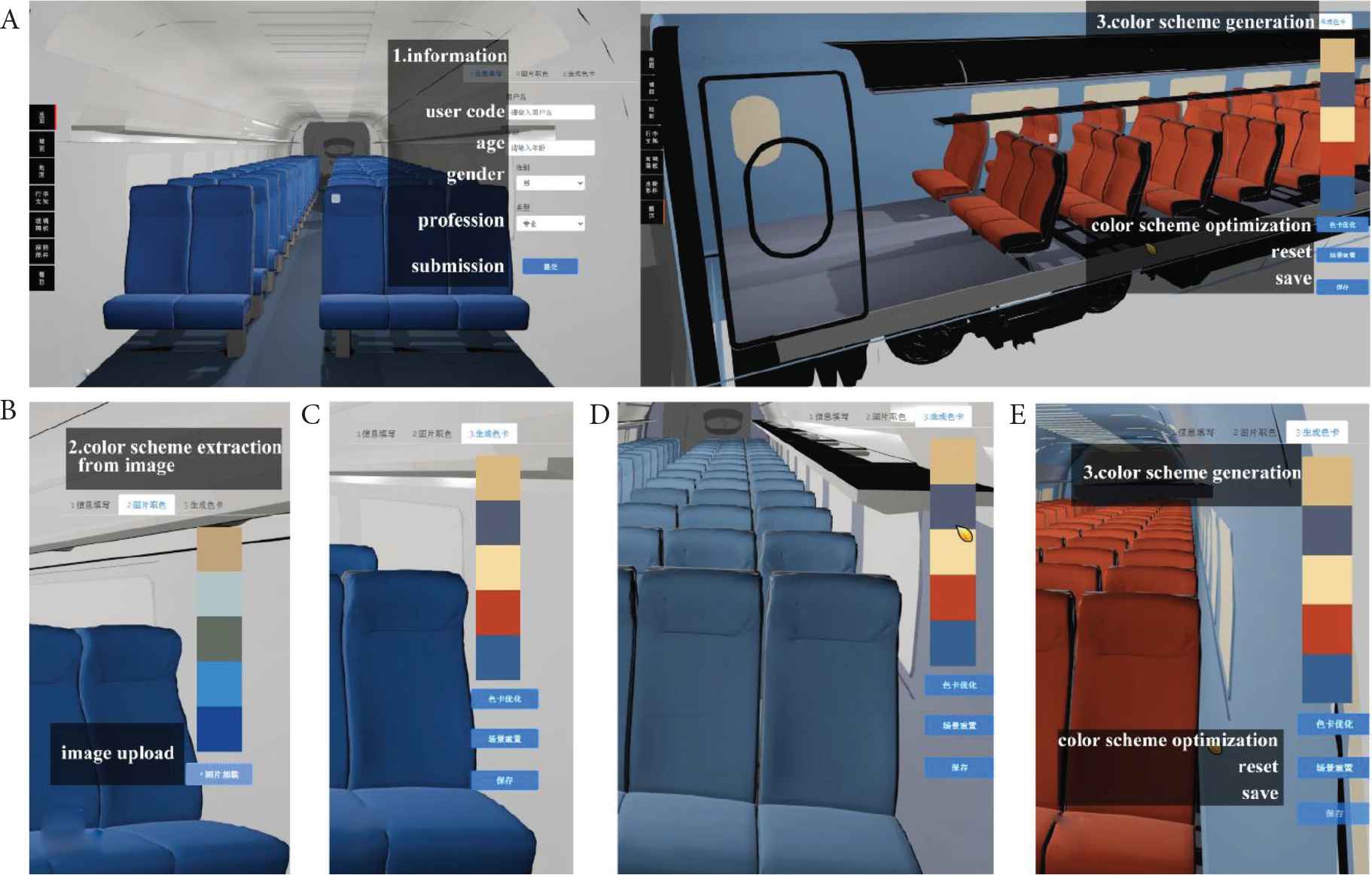
User operate progress.
4.3. User Operate Progress
Each participant needs to complete according to the operating instructions. Otherwise, the system will not record the any data and do not carry out the next-stage operation, thus ensuring the validity of the recorded data. Specifically, the user needs to fill in the basic information first. In the experiment, the preset image range includes 100 images, the image attributes are three channels (R, G, B), and the resolution is greater than 300 Dots Per Inch (DPI). The participant is asked to select a favorite image from the image group provided by us and upload it to the system, show in Figure 3A. The system will extract and generate the CTCS corresponding to the hue based on the image uploaded by the user, such as Figure 3B. The user can choose to use the color scheme or the system automatically optimizes the color palette according to their preference, such as Figure 3C. In the end, users are asked to choose the color scheme from the color palette to the environment of the HSR, and use the five-color scheme to combine a train color scheme that they think meets their aesthetic and visual comfort, shown in Figure 3D and 3E. Participants need to fill out a questionnaire after completing the experimental test.
5. EVALUATION
5.1. Objective Evaluation
5.1.1. Aesthetic evaluation
In this part, we used 40 sets of experimental data as the comparative evaluation, and the result was the original scheme with system-optimized color scheme, through the NIMA model evaluation. 3.00 is used as the threshold for evaluating the quality of the color scheme. The average value of the original results is 3.900, and the average value of the optimized results is 4.100. The aesthetic score of the optimized color scheme is higher than the result of direct color scheme, as shown in Figure 4.

The score of original results and optimization results.
5.2. Time Evaluation
By comparing the data of 94 participants using the system with 10 participants operating in the conventional design process, the average operating time of professionals using this system is 260 s, the average operating time of non-professionals is 170 s. As a reference group, we have invited five design students and experts which are working with general working flow, and without using research system. The operating time by them are far more 600 s. Therefore, through this system that it is possible to efficiently and save time of the users. It narrows the limitation gap of requirement between professional and non-professional background. The operation time comparison is shown in Figure 5.
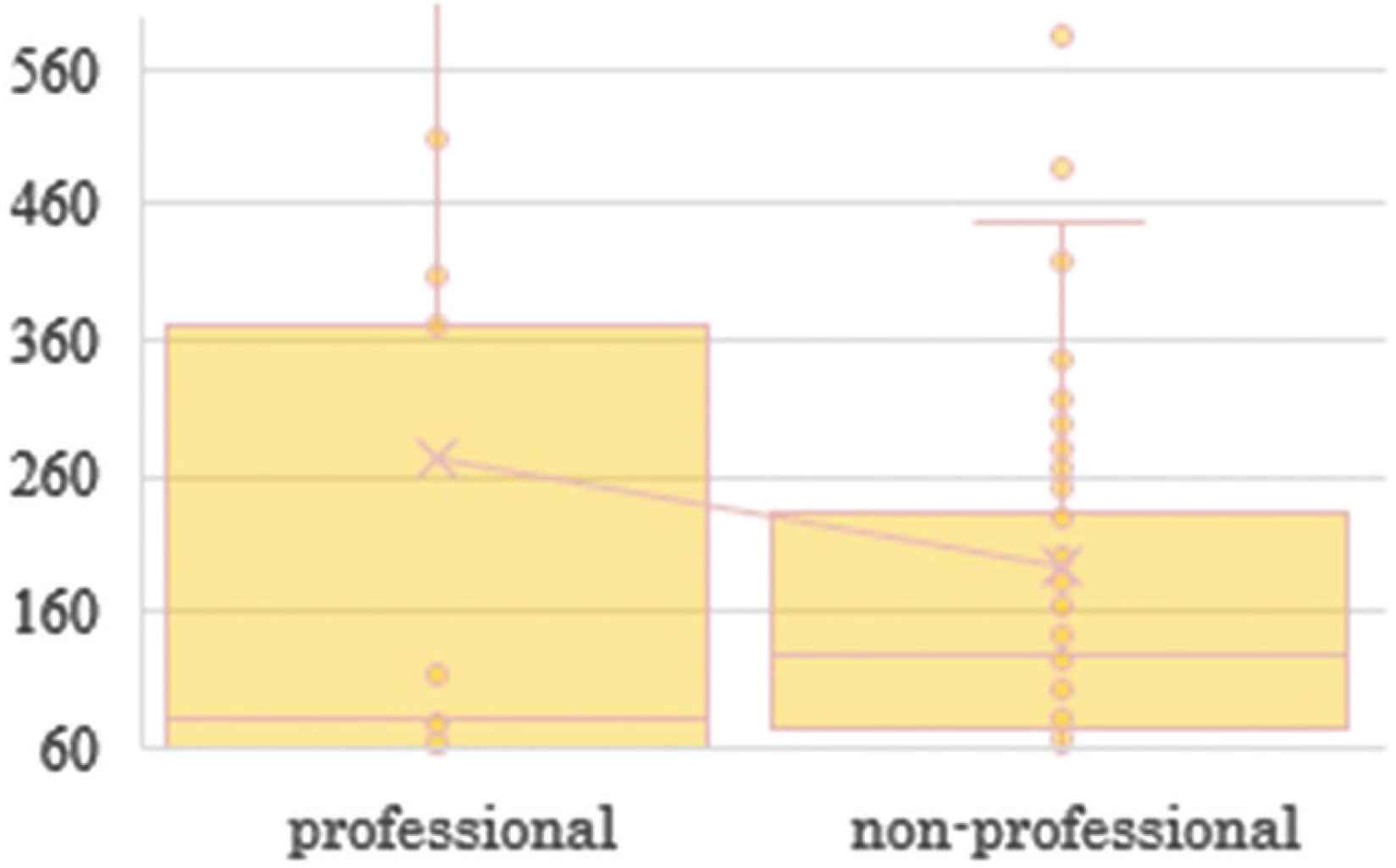
Operation time comparison.
5.2.1. Subjective evaluation
The subjective evaluation includes a six-level scale of five questions, the 0 is very dissatisfied, and the 5 is very satisfied. Q1. Is the extracted color scheme accurate by your feeling? Q2. Is the optimized color pertain to CTCS? Q3. Compared with the un-optimized color scheme, whether the optimized color scheme meets your aesthetics. Q4. Is this system helpful to you with color matching processing. Q5. Does the system help user to comprehend and realize CTCC clearly. The result is shown in Figure 6.
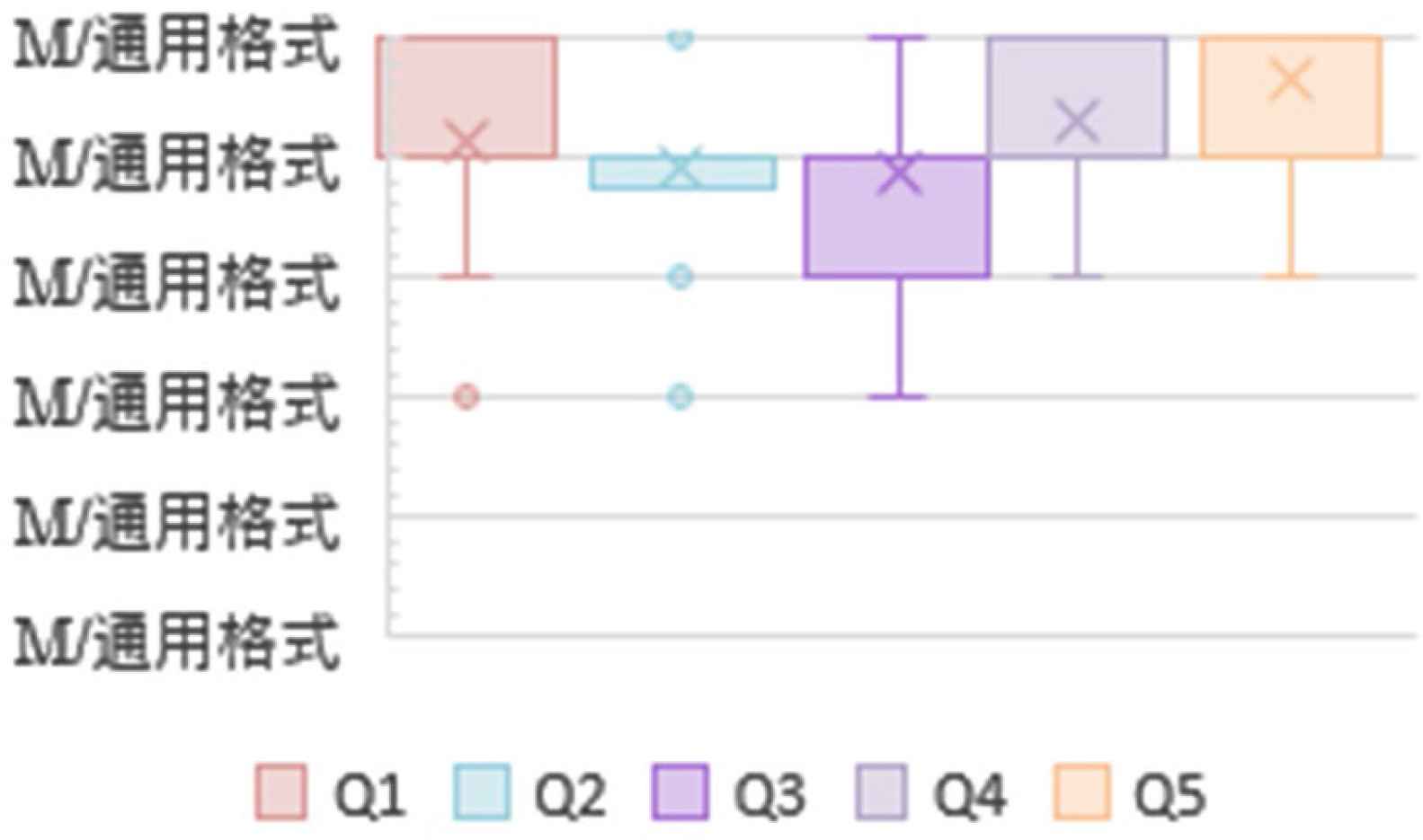
System subjective evaluation.
6. RESULTS
6.1. Original Scheme and Optimized Scheme
In this study, because the data collected in the form is not convenient for visual display, based on the experimental data and results, here show a part of the data reproduction of the experimental results. In the figure, the color scheme on the left is a reproduction of the color enhancement results selected by the experimenter, and the icon on the right is a reproduction of the color scheme finally selected and matched by the experimenter, as shown in Figure 7.

Original scheme and optimized scheme.
6.2. Dominant Tone and Minor Tone
The visual proportions of the dominant tone of the space color scheme and the minor tone are the main factors that form the image of color scheme. Based on the results of the experimental data, we found that the number of clicks and modifications on the walls and seats by the experimenters averaged more than three times, which proved that the seats and walls in the HSR environment space occupy the visual focus. This conclusion is consistent with the research results [21]. At the same time, to further the perceptual cognition formed by the main tone and auxiliary tone of the picture, we used Image Research Institute Inc.’s perceptual cognition method of color to classify the dominant tone and minor tone [9]. Due to the limitation of the scope and quantity of experimental samples and data, the preliminary results are analyzed as examples. Through the suggestions of 10 experts, based on the partial classification results of 95 experimental samples are show in Figure 8, the left side is the Dominant Tone and the right side is the Minor Tone.
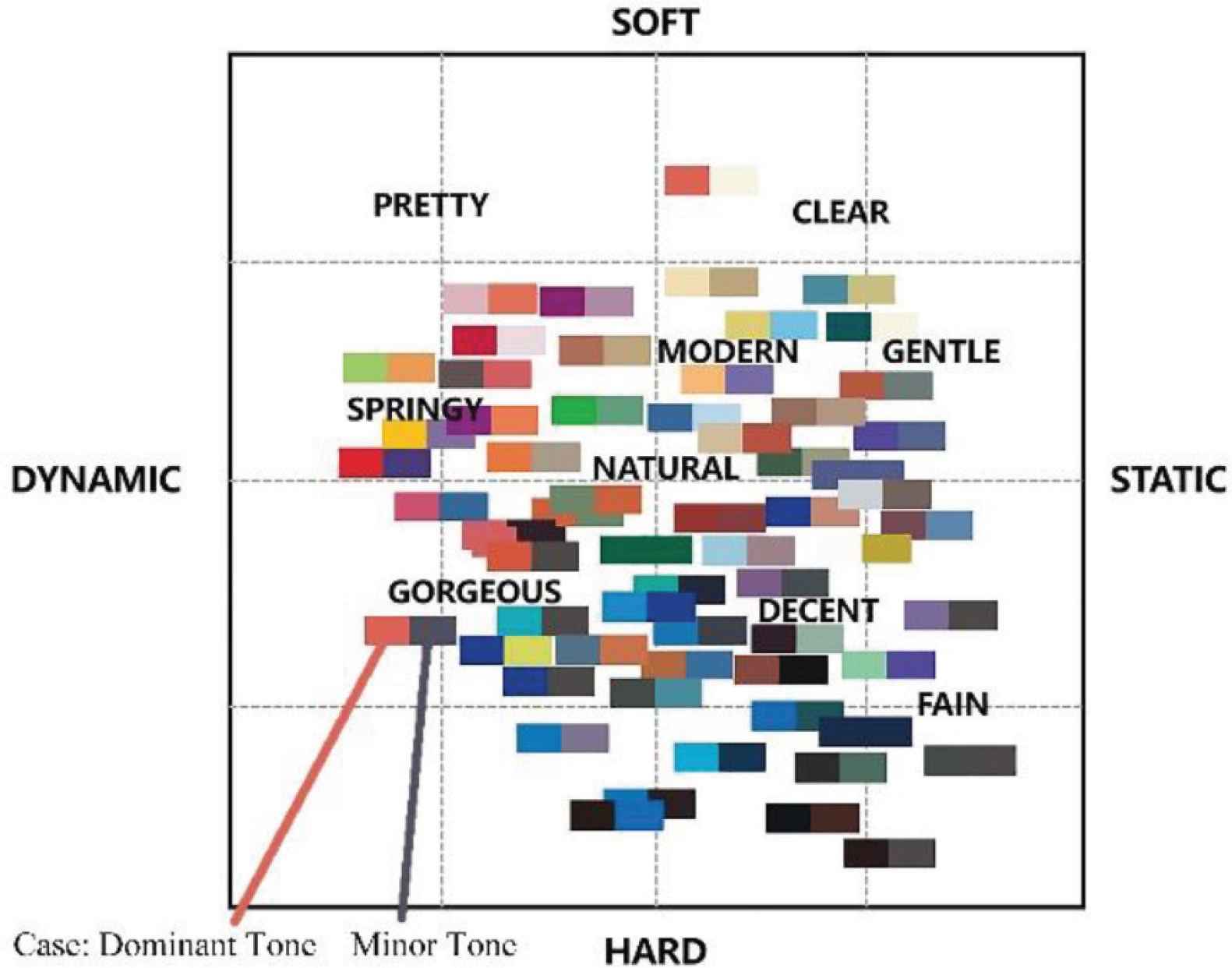
Dominant tone and minor tone.
7. APPLICATION AND FUTURE WORK
At last, to further streamline and optimize the user interaction process and visual experience, this research expands a virtual reality prototype interactive application system based on research data. The system is built using the Unreal Engine. Based on the preliminary results of the dominant tone and the minor tone, we have established corresponding Labels, users only need to pass the preferred perceptual labels to generate the main base palette of CTCS with higher aesthetic scores and in line with their preferences. At the same time, the system can display the original image of the color scheme and the relevant background of the image. Figure 9A is the dominant tone selection interface, user can select preference dominant tone for color scheme. Figure 9B and 9C is the minor tone and ornamental color select settings which is generate by the system operation logic based upon the dominant tone that select by user. User can change detail for whole environment by their preference and all colors is belong to CTCS. As a preliminary prototype system, it needs to be improved in future work. The prototype system user interface is shown in Figure 9.
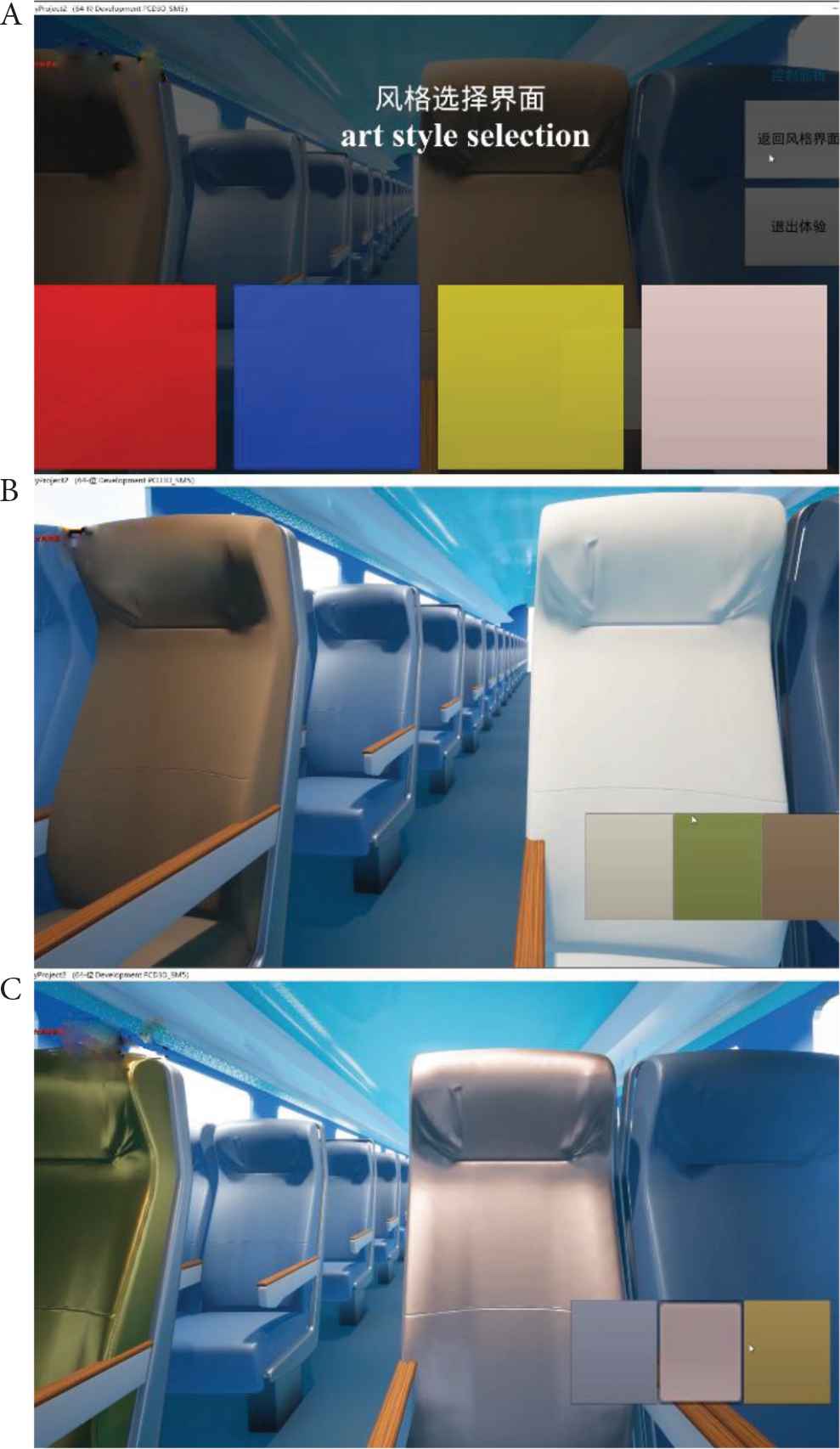
The prototype system user interface.
8. DISCUSSION AND LIMITATION
Through the experimental results and evaluation, it is shown that the interactive system can effectively generate, optimize, assist in the creation and obtain the CTCS for the user’s HSR interior environment, and improve the color matching efficiency. However, there are two limitations.
- (1)
Limitations of the data range. Traditional Chinese color culture is extensive and profound. Although several types of data, such as Dunhuang murals, the Chinese traditional clothing, Chinese traditional textiles, and Chinese ethnic minorities have been integrated with the work, the data range needs to be gradually improved and supplemented with more sphere of learning.
- (2)
The limitations of hardware equipment. When building a website interactive system, taking into account the conditional differences in the hardware performance of each participant’s experimental equipment, to ensure the accuracy of the color value and improve the fluency of experimental operations, we reduced the interactive system visual effects and material effects. Due to the limitation of performance by various users’ computer interactive environment will cause the interactive environment to not achieve a more realistic visual effect. In the future, we will consider improving the visual effect of the interactive environment on the premise of ensuring the fluency of the system.
9. CONCLUSION
The focus of this research is to explore a method of integration and blending, namely color quantification and interactive design, to expand the scope of application of CTCS systems. The two systems proposed by the research, simplifies the process of interactive operation. The unique colors of traditional Chinese culture are coordinate with design elements and design guidelines, and through the behavioral process of human–computer interaction, they can be transformed into each other and conform to human aesthetic preferences. Reduced the dependence of color scheme design on professional knowledge, improved the efficiency of color scheme design, obtained train color scheme data with CTCS characteristics, and carried out preliminary quantification of perceptual factors.
The research proposed by this research is a systematic method, which can provide more exploration ways through the conversion of models and contents. Because the CTCS method is not only satisfied with the human visual pleasure, it is a kind of aesthetic perception.
This unique insight is precise due to the continuous continuation and inheritance of culture and civilization that it has gradually improved and formed the cornerstone of today’s Eastern civilization. Color culture is an important means of communication. CTCC needs to continuously improve basic work and deepen modern people. The cognition and understanding of traditional color culture can continue to be inherited and developed.
CONFLICTS OF INTEREST
The authors declare they have no conflicts of interest.
ACKNOWLEDGMENT
The authors thanks the supplement by Dalian Science and Technology Innovation Fund Project. The Number: (2020JJ27FZ126).
AUTHORS INTRODUCTION
Mr. Liangyu Shi
 He received his M.S. from the Department of Design, Dalian Polytechnic University, China in 2018. He is currently a Doctoral course student in Japan Advanced Institute of Science and Technology, Japan. His research interest includes human computer interaction, Virtual Reality applications.
He received his M.S. from the Department of Design, Dalian Polytechnic University, China in 2018. He is currently a Doctoral course student in Japan Advanced Institute of Science and Technology, Japan. His research interest includes human computer interaction, Virtual Reality applications.
Dr. Wei Pei
 He is a Professor at College of Environmental Science and Engineering, Dalian Maritime University, Dalian, China. D. Eng., His main research interests include Artificial Intelligence, image processing, pattern recognition.
He is a Professor at College of Environmental Science and Engineering, Dalian Maritime University, Dalian, China. D. Eng., His main research interests include Artificial Intelligence, image processing, pattern recognition.
Mr. Jinfeng Li
 He is currently a master course student in College of Information Science and Technology, Dalian Maritime University, Dalian, China. B. Eng., M. Eng. His main research interest is Artificial Intelligence.
He is currently a master course student in College of Information Science and Technology, Dalian Maritime University, Dalian, China. B. Eng., M. Eng. His main research interest is Artificial Intelligence.
Dr. Kazunori Miyata
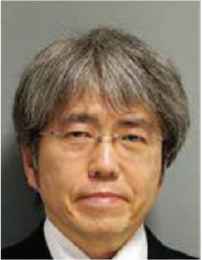 He is a Professor at School of Knowledge Science in Japan Advanced Institute of Science and Technology. He received a PhD degree (Engineering) from Tokyo Institute of Technology, Japan, in 1996. His research interest includes computer graphics, media art, and multimedia applications. He is the 4th president of the Society for Art and Science, and a member of ACM, IEEE, IPSJ, IEICE, and others.
He is a Professor at School of Knowledge Science in Japan Advanced Institute of Science and Technology. He received a PhD degree (Engineering) from Tokyo Institute of Technology, Japan, in 1996. His research interest includes computer graphics, media art, and multimedia applications. He is the 4th president of the Society for Art and Science, and a member of ACM, IEEE, IPSJ, IEICE, and others.
Dr. Siqun Ma
 He is a Professor in the School of Locomotive and Rolling Stock Engineering of Dalian Jiaotong University. He received the doctorate in mechanical manufacturing and automation from Dalian Jiaotong University in 2006. His main research interest includes computer graphics, virtual reality system development and CAD/CAE integration technology.
He is a Professor in the School of Locomotive and Rolling Stock Engineering of Dalian Jiaotong University. He received the doctorate in mechanical manufacturing and automation from Dalian Jiaotong University in 2006. His main research interest includes computer graphics, virtual reality system development and CAD/CAE integration technology.
Dr. Haoran Xie
 He is a Senior Lecturer at Japan Advanced Institute of Science and Technology (JAIST) from October 2020. He received PhD and M.S. in Computer Graphics from JAIST (2015). His research interest includes Interactive Computer Graphics, Deep Learning, Human-Computer Interaction, Visual Computation, Human Augmentation and Soft Robotics.
He is a Senior Lecturer at Japan Advanced Institute of Science and Technology (JAIST) from October 2020. He received PhD and M.S. in Computer Graphics from JAIST (2015). His research interest includes Interactive Computer Graphics, Deep Learning, Human-Computer Interaction, Visual Computation, Human Augmentation and Soft Robotics.
REFERENCES
Cite this article
TY - JOUR AU - Liangyu Shi AU - Wei Pei AU - Jinfeng Li AU - Kazunori Miyata AU - Siqun Ma AU - Haoran Xie PY - 2021 DA - 2021/12/29 TI - Chinese Traditional Color Harmony Inheritance Method for High-speed Railway JO - Journal of Robotics, Networking and Artificial Life SP - 304 EP - 311 VL - 8 IS - 4 SN - 2352-6386 UR - https://doi.org/10.2991/jrnal.k.211108.015 DO - 10.2991/jrnal.k.211108.015 ID - Shi2021 ER -
